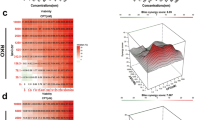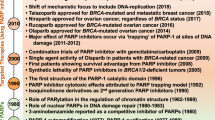Abstract
I. Background: A combination of etoposide (VP-16) and cisplatin (CDDP) is the standard treatment for certain colon cancers. These drugs promote the death of cancer cells via direct and indirect induction of the most lethal DNA lesions – DNA double-stand breaks. However, cancer cells can reverse the DNA damaging effect of anticancer drugs by triggering DNA repair processes. In eukaryotic cells, the main DNA repair pathway responsible for DNA double-stand breaks repair is non-homologous end-joining (NHEJ). Inhibitors of DNA repair are of special interest in cancer research as they could break the cellular resistance to DNA-damaging agents and increase the efficiency of standard cancer treatments. In this study, we investigated the effect of two NHEJ inhibitors, SCR7 and NU7441, on the cytotoxic mechanism of VP-16/CDDP in a LoVo human colorectal adenocarcinoma cell line. SCR7 blocks Ligase IV-mediated joining by interfering with its DNA binding, whereas NU7441 is a highly potent and selective DNA-PK inhibitor.
II. Methods and Results: Both inhibitors synergistically increased the cytotoxicity of CDDP and VP-16 when combined, but the effect of SCR7 was more pronounced. SCR7 and NU7441 also significantly increased VP-16; CDDP induced DNA double-stand breaks level and delayed drug-induced DSB repair, as seen on the comet assay and measured using H2AX foci. We also observed changes in cell cycle distribution and enhanced apoptosis ratio in colorectal adenocarcinoma cells treated with DNA repair inhibitors and VP-16/CDDP.
III. Conclusions: Our data support the hypothesis that NHEJ inhibitors could be used in conjunction with standard therapy to provide effective clinical improvement and allow reduction in drug doses.





Similar content being viewed by others
Availability of data and material
Raw data were generated at University of Lodz. Derived data supporting the findings of this study are available from the corresponding author TP on request.
References
Aran V, Victorino AP, Thuler LC, Ferreira CG (2016) Colorectal Cancer: epidemiology, disease mechanisms and interventions to reduce onset and mortality. Clin Colorectal Cancer 15:195–203. https://doi.org/10.1016/j.clcc.2016.02.008
Naganna SM, Vidyavathi K, Kumar HM, Bhaskaran A (2016) Histomorphological characteristics of colorectal carcinoma in the young and elderly: is there a difference? Indian J Pathol Oncol 3:293. https://doi.org/10.5958/2394-6792.2016.00056.9
Pestana JSG, Martins SFF (2016) Colorectal cancer: comparative analysis of clinical and pathological characteristics in patients aged above and below 45 years of age and impact on prognosis. J Coloproctology 36:196–202. https://doi.org/10.1016/j.jcol.2016.04.010
Holch J, Stintzing S, Heinemann V (2016) Treatment of metastatic colorectal Cancer: standard of care and future perspectives. Visc Med 32:178–183. https://doi.org/10.1159/000446052
Souglakos J (2007) Genetic alterations in sporadic and hereditary colorectal Cancer: implementations for screening and follow-up. Dig Dis 25:9–19. https://doi.org/10.1159/000099166
Lieber MR (2010) The mechanism of double-Strand DNA break repair by the nonhomologous DNA end joining pathway. Annu Rev Biochem 79:181–211. https://doi.org/10.1146/annurev.biochem.052308.093131
Liang F, Han M, Romanienko PJ, Jasin M (1998) Homology-directed repair is a major double-strand break repair pathway in mammalian cells. Proc Natl Acad Sci 95:5172–5177
Kelley MR, Logsdon D, Fishel ML (2014) Targeting DNA repair pathways for cancer treatment: what’s new? Future Oncol 10:1215–1237. https://doi.org/10.2217/fon.14.60
Kopa P, Macieja A, Galita G et al (2019) DNA double Strand breaks repair inhibitors: relevance as potential new anticancer therapeutics. Curr Med Chem 26:1483–1493. https://doi.org/10.2174/0929867325666180214113154
Kopa P, Macieja A, Gulbas I et al (2020) Inhibition of DNA-PK potentiates the synergistic effect of NK314 and etoposide combination on human glioblastoma cells. Mol Biol Rep 47:67–76. https://doi.org/10.1007/s11033-019-05105-x
Macieja A, Kopa P, Galita G et al (2019) Comparison of the effect of three different topoisomerase II inhibitors combined with cisplatin in human glioblastoma cells sensitized with double strand break repair inhibitors. Mol Biol Rep 46:3625–3636. https://doi.org/10.1007/s11033-019-04605-0
Pastwa E, Poplawski T, Lewandowska U et al (2014) Wortmannin potentiates the combined effect of etoposide and cisplatin in human glioma cells. Int J Biochem Cell Biol 53:423–431. https://doi.org/10.1016/j.biocel.2014.06.007
Zoppoli G, Regairaz M, Leo E et al (2012) Putative DNA/RNA helicase Schlafen-11 (SLFN11) sensitizes cancer cells to DNA-damaging agents. Proc Natl Acad Sci U S A 109:15030–15035. https://doi.org/10.1073/pnas.1205943109
Carrillo AM, Hicks M, Khabele D, Eischen CM (2015) Pharmacologically increasing Mdm2 inhibits DNA repair and cooperates with genotoxic agents to kill p53-inactivated ovarian Cancer cells. Mol Cancer Res MCR 13:1197–1205. https://doi.org/10.1158/1541-7786.MCR-15-0089
Pujol J-L, Roch B, Pujol CN, Goze C (2018) Medical treatment of small cell lung cancer: can we leave the area of cisplatin-etoposide? Bull Cancer (Paris) 105:955–966. https://doi.org/10.1016/j.bulcan.2018.05.014
Gkotzamanidou M, Terpos E, Bamia C et al (2016) DNA repair of myeloma plasma cells correlates with clinical outcome: the effect of the nonhomologous end-joining inhibitor SCR7. Blood 128:1214–1225. https://doi.org/10.1182/blood-2016-01-691618
Dong J, Dong J, Ren Y et al (2018) Inactivation of DNA-PK by knockdown DNA-PKcs or NU7441 impairs non-homologous end-joining of radiation-induced double strand break repair. Oncol Rep 39:912–920
Mundade R, Imperiale TF, Prabhu L et al (2014) Genetic pathways, prevention, and treatment of sporadic colorectal cancer. Oncoscience 1:400–406
Ahmed D, Eide PW, Eilertsen IA et al (2013) Epigenetic and genetic features of 24 colon cancer cell lines. Oncogenesis 2:e71. https://doi.org/10.1038/oncsis.2013.35
Mouradov D, Sloggett C, Jorissen RN et al (2014) Colorectal cancer cell lines are representative models of the main molecular subtypes of primary cancer. Cancer Res 74:3238–3247. https://doi.org/10.1158/0008-5472.CAN-14-0013
Wang J, Mouradov D, Wang X et al (2017) Colorectal Cancer cell line proteomes are representative of primary tumors and predict drug sensitivity. Gastroenterology 153:1082–1095. https://doi.org/10.1053/j.gastro.2017.06.008
Chou T-C (2010) Drug combination studies and their synergy quantification using the Chou-Talalay method. Cancer Res 70:440–446. https://doi.org/10.1158/0008-5472.CAN-09-1947
Wozniak K, Szaflik JP, Zaras M et al (2009) DNA damage/repair and polymorphism of the hOGG1 gene in lymphocytes of AMD patients. J Biomed Biotechnol 2009:827562. https://doi.org/10.1155/2009/827562
Zhao Y, Thomas HD, Batey MA et al (2006) Preclinical evaluation of a potent novel DNA-dependent protein kinase inhibitor NU7441. Cancer Res 66:5354–5362
Hsu F-M, Zhang S, Chen BPC (2012) Role of DNA-dependent protein kinase catalytic subunit in cancer development and treatment. Transl Cancer Res 1:22–34. https://doi.org/10.3978/j.issn.2218-676X.2012.04.01
Rapp A (2004) After double-strand break induction by UV-A, homologous recombination and nonhomologous end joining cooperate at the same DSB if both systems are available. J Cell Sci 117:4935–4945. https://doi.org/10.1242/jcs.01355
Alikarami F, Safa M, Faranoush M et al (2017) Inhibition of DNA-PK enhances chemosensitivity of B-cell precursor acute lymphoblastic leukemia cells to doxorubicin. Biomed Pharmacother 94:1077–1093. https://doi.org/10.1016/j.biopha.2017.08.022
Dai Y, Jin S, Li X, Wang D (2017) The involvement of Bcl-2 family proteins in AKT-regulated cell survival in cisplatin resistant epithelial ovarian cancer. Oncotarget 8:1354–1368. https://doi.org/10.18632/oncotarget.13817
Srivastava M, Nambiar M, Sharma S et al (2012) An inhibitor of nonhomologous end-joining abrogates double-Strand break repair and impedes Cancer progression. Cell 151:1474–1487. https://doi.org/10.1016/j.cell.2012.11.054
Dasari S, Tchounwou PB (2014) Cisplatin in cancer therapy: molecular mechanisms of action. Eur J Pharmacol 740:364–378
Eastman A (1999) The mechanism of action of cisplatin: from adducts to apoptosis. Cisplatin Chem Biochem Lead Anticancer Drug:111–134
Yanai M, Makino H, Ping B et al (2017) DNA-PK inhibition by NU7441 enhances Chemosensitivity to topoisomerase inhibitor in non-small cell lung carcinoma cells by blocking DNA damage repair. Yonago Acta Med 60:9–15
McCormick A, Donoghue P, Dixon M et al (2017) Ovarian Cancers Harbor defects in nonhomologous end joining resulting in resistance to Rucaparib. Clin Cancer Res Off J Am Assoc Cancer Res 23:2050–2060. https://doi.org/10.1158/1078-0432.CCR-16-0564
Sunada S, Kanai H, Lee Y et al (2016) Nontoxic concentration of DNA-PK inhibitor NU7441 radio-sensitizes lung tumor cells with little effect on double strand break repair. Cancer Sci 107:1250–1255. https://doi.org/10.1111/cas.12998
Yu L, Shang Z-F, Hsu F-M et al (2015) NSCLC cells demonstrate differential mode of cell death in response to the combined treatment of radiation and a DNA-PKcs inhibitor. Oncotarget 6:3848–3860. https://doi.org/10.18632/oncotarget.2975
Yang C, Wang Q, Liu X et al (2016) NU7441 enhances the Radiosensitivity of liver Cancer cells. Cell Physiol Biochem Int J Exp Cell Physiol Biochem Pharmacol 38:1897–1905. https://doi.org/10.1159/000445551
van Oorschot B, Granata G, Di Franco S et al (2016) Targeting DNA double strand break repair with hyperthermia and DNA-PKcs inhibition to enhance the effect of radiation treatment. Oncotarget 7:65504–65513. https://doi.org/10.18632/oncotarget.11798
Vávrová J, Zárybnická L, Jošt P et al (2016) Comparison of the Radiosensitizing effect of ATR, ATM and DNA-PK kinase inhibitors on cervical carcinoma cells. Folia Biol (Praha) 62:167–174
Azad A, Bukczynska P, Jackson S et al (2014) Co-targeting deoxyribonucleic acid-dependent protein kinase and poly(adenosine diphosphate-ribose) polymerase-1 promotes accelerated senescence of irradiated cancer cells. Int J Radiat Oncol Biol Phys 88:385–394. https://doi.org/10.1016/j.ijrobp.2013.10.043
Greco GE, Matsumoto Y, Brooks RC et al (2016) SCR7 is neither a selective nor a potent inhibitor of human DNA ligase IV. DNA Repair 43:18–23. https://doi.org/10.1016/j.dnarep.2016.04.004
John F, George J, Srivastava M et al (2015) Pluronic copolymer encapsulated SCR7 as a potential anticancer agent. Faraday Discuss 177:155–161. https://doi.org/10.1039/C4FD00176A
John F, George J, Vartak SV et al (2015) Enhanced efficacy of pluronic copolymer micelle encapsulated SCR7 against cancer cell proliferation. Macromol Biosci 15:521–534. https://doi.org/10.1002/mabi.201400480
Mouradov D, Slogget C, Jorissen RN et al (2014) Colorectal cancer cell lines are representative models of the main molecular subtypes of primary cancer. Cancer Res 74(12):3238–3247. https://doi.org/10.1158/0008-5472.CAN-14-0013
Ahmed D, Eide PW, Eilertsen IA et al (2013) Epigenetic and genetic features of 24 colon cancer cell lines. Oncogenesis 2(9):e71. https://doi.org/10.1038/oncsis.2013.35
Acknowledgements
This work was financially supported by the National Science Centre (NCN, Poland) grant, according to the decision No. DEC-2013/11/B/NZ7/01340.
Funding
This work was financially supported by the National Science Center (NCN, Poland) grant, according to the decision No. DEC-2013/11/B/NZ7/01340.
Author information
Authors and Affiliations
Contributions
PK performed the experiments, analyzed the data, interpreted the results and wrote the manuscript; AM participated in the laboratory work, interpreting results and wrote the manuscript; EP and IM participated in the design of the study, critically reviewed the manuscript; TP supervised overall study, analyzed data, and critically reviewed manuscript. All authors read and approved the final manuscript.
Corresponding author
Ethics declarations
Conflict of interest
The authors report no conflict of interest.
Research involving human participants and/or animals
Not applicable.
Informed consent
Not applicable.
Additional information
Publisher's Note
Springer Nature remains neutral with regard to jurisdictional claims in published maps and institutional affiliations.
Electronic supplementary material
Below is the link to the electronic supplementary material.
Rights and permissions
About this article
Cite this article
Kopa, P., Macieja, A., Pastwa, E. et al. DNA double-strand breaks repair inhibitors potentiates the combined effect of VP-16 and CDDP in human colorectal adenocarcinoma (LoVo) cells. Mol Biol Rep 48, 709–720 (2021). https://doi.org/10.1007/s11033-020-06124-9
Received:
Accepted:
Published:
Issue Date:
DOI: https://doi.org/10.1007/s11033-020-06124-9




